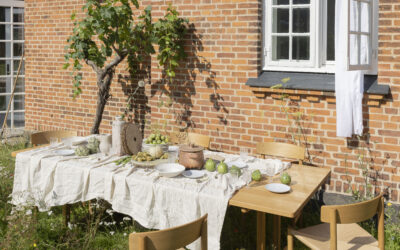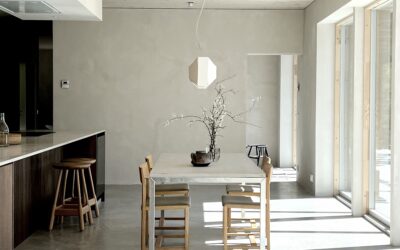Homewear on the rise: how the pandemic influenced our fashion choices
The fact that last year was tumultuous, to say the least, comes as a surprise to no one. As the virus spread and the pandemic were underway it forced most countries to shut down and pushed people indoors. This required and brought a number of changes – including our fashion choices. When stuck at home, naturally homewear becomes everyday-wear and so, the trend was fast-approaching.
We’ve gained prodigious insights from Carla Buzasi, CEO at trend forecasters WGSN and Maria Glæsel, CEO & Partner at loungewear brand Aiayu, about what the pandemic has meant for our fashion and what post-pandemic trends might look like.
Growing preference for comfort
In the days prior to lockdowns, regulated times for outdoor activity, and mask mandates, our fashion preferences had begun shifting. An increased interest in comfortability has been on the rise for the past couple of years, with athleisure at the forefront.
With casual clothes becoming more and more functional and gym clothes designed to look good even outside the gym perhaps a mix of styles was inevitable. And so, a shift of trends was on the horizon. Wanting clothing to show off one’s lifestyle and values has become increasingly important to us.
Since athleisure, harmonizes perfectly with the increased focus on sustainability and wellness we have seen in recent years, it likely plays a role in why consumers wholeheartedly have accepted the comfortable style phenomena.
In 2019, Forbes predicted that the athleisure trend was going to persist thanks to the growth of “comfort-oriented silhouettes”. Along with that, in early 2020, before the pandemic had come to its full fruition Refinery29 stated that the coming fashion year would put coziness and being comfortable at the forefront.
Homewear set to take over our lockdown lifestyle
As the pandemic forced us to swap the outdoors for indoors, it required many to work from home and cancel most social events. When our otherwise immense, globalized world suddenly shrunk into the size of a screen and four walls, even athleisure did not meet our comfortability quota.
Now that we no longer had places to go get dressed for the day started looking a lot different. Our need for fashionable clothing halted, homewear surged and quickly became our main fashion choice.
Although spending on clothes reached all-time lows amid covid-19, loungewear was the one category to see a rise in demand.
Sustainable Danish house and homewear brand Aiayu can attest to this:
The brand has been creating exclusive essentials for a conscious home and wardrobe, using nature’s best materials for over 15 years. And their success has continued throughout the pandemic, as they have seen continued growth and increased demand in all their product categories.
Brand CEO & partner Maria Glæsel describes how they’ve noticed their quality-conscious consumers increased desire to create an elevated home experience. Both in terms of lounge apparel and interior products. Further explaining it she says:
“People are wanting to invest in and elevate their homes and everyday lives, which matches our product universe well.
[They] want versatile everyday items they can wear to a virtual meeting and look professional and pulled together, but also feel entirely comfortable and effortless.
The same applies to home items, people are choosing to invest in products which make another night-in feel a bit more special and elegant.”
Homewear, not just “a sign of the times”
With the rise of athleisure, and not to mention the streetwear trend – that also alludes to a rather comfortable aesthetic with oversized and baggy garments, the homewear trend was well on its way to gaining momentum. And hence, bound to be popularized. That it would require the world to come to a standstill first was, however, more unexpected.
Glæsel, however, emphasizes that Aiayu’s continued success during the pandemic is not solely to be related to something as “a sign of the times”. She rather equates it to their reluctance of adopting a fast-paced, trend-driven approach saying:
“Comfortable luxury is integrated into the design of every Aiayu item. Our “slow fashion” ethos means we have always [been] committed to creating versatile, luxurious, high-quality items that work equally well at home as they do out.
As an original adopter of this model, we have found a core customer group which has always appreciated this about our brand, but given our products’ deep resonance with the current times, our customer base has continued to grow.”
She continues by explaining that: “Research has shown that the pandemic has increased consumer interest in sustainability and that they are happy to see consumers choosing to support brands committed to reducing environmental impacts.”
Just as the rise of athleisure could have correlations to a growing interest in wellness, this raises the question, of loungewear’s rise could be tied to an increased environmental consciousness? Seeing as we grow more conscious of what we choose to purchase and dress in.
Regardless, when our desire to be comfortable overthrows that of dressing up, fashion as a status symbol and measure for well-being renders nearly useless. Judging by this, dressing up might become less about “looking the part”, and more about “feeling the part”.

Aiayu Domus campaign image – “Marlon Throw” blanket
The next trends approaching: Introducing Athflow and Cocoon Swoon
In its annual ‘Pinterest Predicts’ trend report Pinterest forecasts loungewear is here to stay throughout 2021. Though the end of lockdown season seems to be nearing, this doesn’t mean we’ll suddenly shed our comfy layers.
The report introduces both Cocoon Swoon (the new layering) and Athflow (where athleisure meets elegance) as the styles that will take homewear out into the streets.
Atflow
Where the Athleisure trend brought outdoor workout clothes indoors, according to Pinterest, Athflow adds a touch of elegance, making the look both functional and aesthetically interesting.
It’s about comfort in all aspects of life with pieces that can easily be dressed up or down depending on whether one’s headed for the office, a yoga class, or the couch.
Cocoon Swoon
is similar in adapting loungewear to both the continuation of the out of the office and a return to the out of home life. It’s all about layering comfy clothes.
Pinterest explains in its report that the cozy aspect of the trend takes inspiration from our interiors: That feeling of rolling out of bed to our desk in a duvet-burrito? You can take it with you wherever you go. Coincidentally, those are the precise desires Aiayu has seen grow amongst its consumers, as mentioned above.
Always according to the report, the most popular search terms linked to the fashion trends were ‘house dresses for women’, ‘co-ord outfits’, ‘oversized and soft outfits’, as well as ‘cozy aesthetic outfits’, ‘cocoon cardigan’, ‘fluffy slippers’ and finally ‘slouch socks’.
Judging by these search terms it seems the trends will mostly gain traction in the US and the UK. Although interest can be seen in European markets such as France, Germany, Italy, and the UK as well.
In alignment with this, we spoke to Carla Buzasi, CEO at trend forecasters WGSN, who told us:
“Key elements of the [homewear] look are evolving, including the rise in ‘2-mile wear’ and ‘at-home lounge’, which are subtly different to athleisure.”
Post-pandemic world on the horizon – taking homewear outdoors
Since we’ve grown accustomed to wearing comfortable lounge clothes for the past months it raises the question of how we will want to dress when there is reason to dress up again.
For absolute comfort, as pointed out by Pinterest Predicts and Net-a-Porter, we’ll venture out in-house slippers. The slouch socks and slacks from the aforementioned cozy trends will be topped off with slippers that will have you walk on clouds – almost literally. The fluffier the better it seems, even for SS21.
According to Carla Buzasi, the lifestyle changes the pandemic brought will leave deep traces for how we will want to dress in the future, but not change it fundamentally. She explains:
“All our research, suggests that comfortwear is here to stay, driven by the lifestyle shifts we’ve seen over the past 12 months that will outlast the pandemic, such as working from and exercising at home.
However, that doesn’t mean we won’t want to dress up at all and [that] the actual volumes of this kind of clothing will decrease VS 2020, [rather it will be] stabilizing somewhere between the levels of 2019 and 2020”
Carla Buzasi, CEO at trend forecasters WGSN
Similarly, Pinterest Predicts prides itself on its accuracy in presenting trends before they’re trending – according to the social medium, eight out of ten of their 2020 predictions actually came true.
Those who kept a close eye on the global fashion week runways for SS21 and FW21 can only agree with that statement. British Vogue highlighted what it calls the ‘living room disco’ look which – in line with Athflow – can be defined as ‘relaxed glamour’ or ‘comfy chic’.
Cocooning galore on those runways too, as British Vogue notes how we’ll take the fluffy comfort of hoodies and blankets on our post-pandemic journey. Prada, Hermès, Max Mara, and others showed their low-key yet luxe approach with hoodies, functional skirts, and puffer jackets.

Rotate Birger Christensen AW21

Rotate Birger Christensen is one such example. The Danish brand is known for creating coveted styles for the festive wardrobe and offering a sexy take on everything from miniskirts and suiting to accessories. After glancing through their AW21 collection, it becomes apparent that even they have jumped on the pandemic fashion bandwagon. As they introduce sweatpants and pair glittery dresses with cozy cardigans, something they haven’t done pre-pandemic.
A future in comfort
As for what the future holds, homewear brands and trend forecasters seem to agree. Maria Glæsel of Aiayu says she “does not believe the demand for homewear will subside any time soon”.
As customers have experienced the benefits of curating a beautiful home environment and a more comfortable, streamlined wardrobe, she finds it hard to imagine people abandoning those practices. Similarly, Carla Buzasi of WGSN explains that “the overriding consumer demand will essentially be for comfort, whatever we might be doing.”
The shift to rewarding comfortability in clothes speaks to the fact that fashion is an ever-evolving industry, reflective of the times we live through. If life before the pandemic was characterized by casual sporty attire signaling comfort, life in a pandemic has notched the dress-code up a few levels on the comfortability scale.
While the post-pandemic outfit will likely add a bit of luxury to our homewear look. Whether that be in terms of material origin or explicitly glittery dresses.
Image of Maria Glæsel: Instagram – Image of Carla Buzasi: Carlabuzasi.com – Images of Rotate Birger Christensen looks: courtesy of Copenhagen Fashion Week imagebank.
Cerena is the Lifestyle Researcher for the US market at VOCAST. She has a degree in Media and Communications and has previously worked with fashion PR. She cares for inclusion within the industry and when not working she’s a dedicated snacker and music listener.
Wided is the Lifestyle Researcher for the Belgian and Dutch markets at VOCAST. She’s a Belgian editor and author with a background in journalism. In London, she established a career in digital marketing for fashion and interior design brands. When she’s not working or studying for her Master’s, you’ll find her in front of a canvas, paintbrushes in hand.
SIGN UP TO OUR NEWSLETTER
Get free knowledge on how to optimize your B2B marketing & new product releases.
RELATED POSTS
The Art of Slow Living: When Thoughtful Choices Redefine Design
With a fast-paced everyday life, the principles of slow living stand in a sharp and perhaps comforting contrast. As the movement progresses, more people are integrating the values of slow living into all areas of their lives – from slow food to slow fashion and slow...
Mastering Sustainable Branding in Interior Design
In recent years, the appeal of trendy marble coffee tables, plush sofas, and finely designed lamps has captivated us all. While the interior design industry often embodies craftsmanship, it also has a less glamorous side: its environmental impact. This reality has...
Beyond the Aesthetic: The Emergence of Stylists as Influencers
In the realm of interior design, stylists, recognized for turning creative visions into captivating editorial and commercial projects, are increasingly emerging as key influencers on social media. The rise of digital platforms has substantially redefined their roles,...







